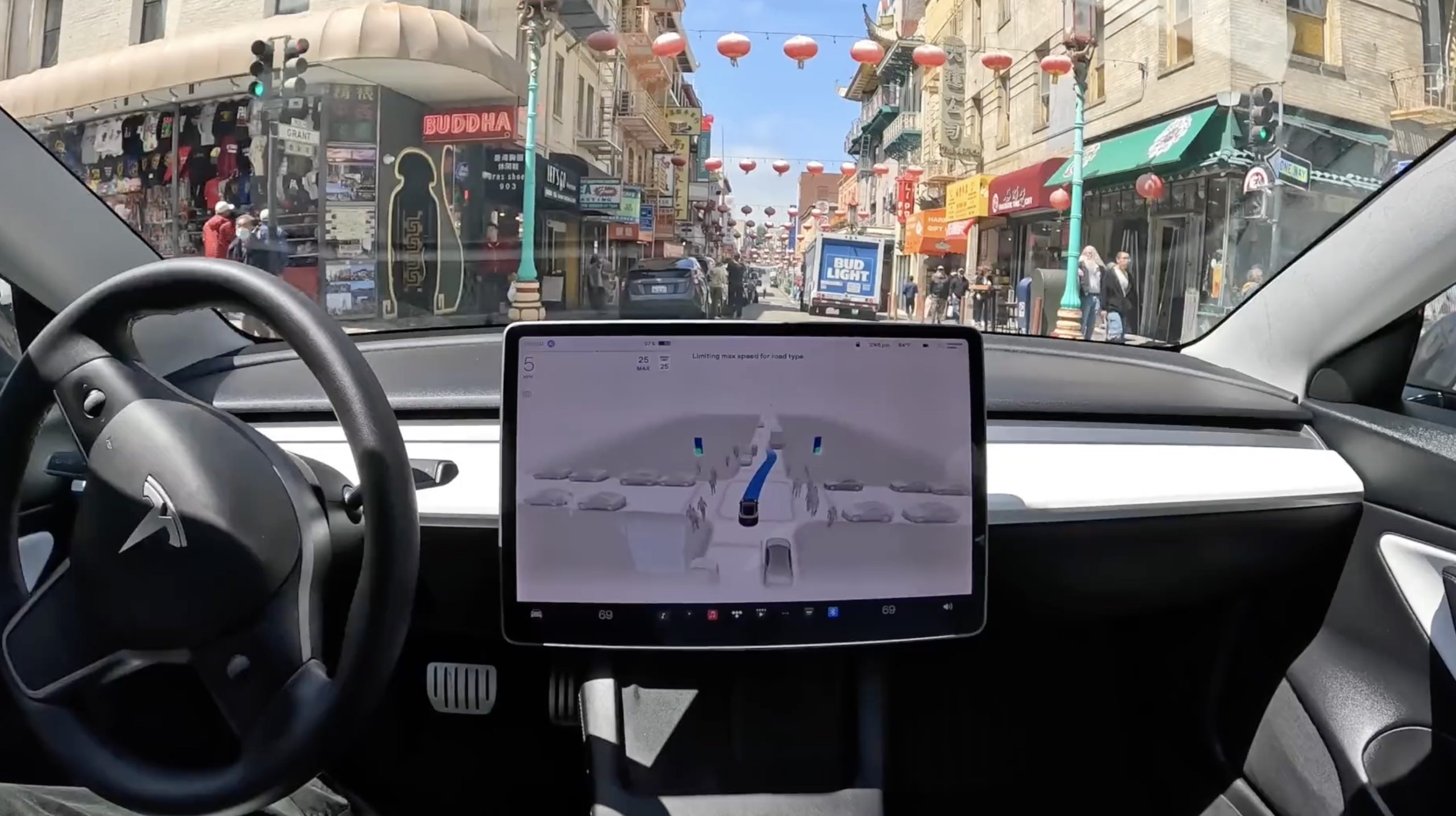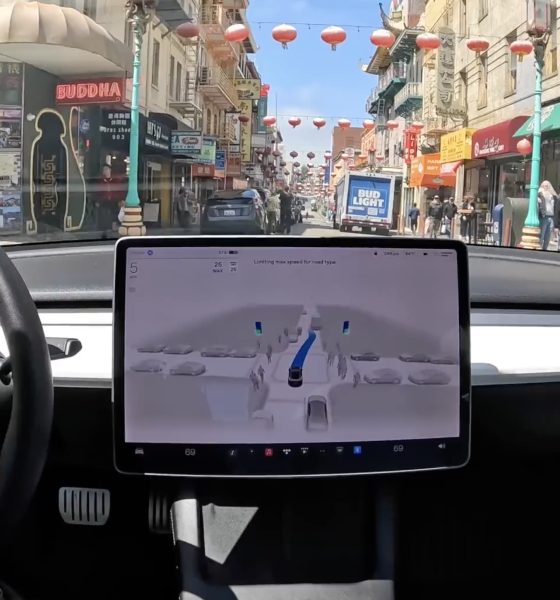Walter Isaacson’s Elon Musk biography is set to be published on Tuesday, and a new preview of the book illustrates details about Tesla’s development of the upcoming Full Self-Driving (FSD) version 12.
In an additional preview of his Musk biography for CNBC, Isaacson discusses the use of AI in the development of Tesla’s FSD v12, in a shift that took place within the last several months. Isaacson talks about Tesla’s recent development of the upcoming FSD v12, which he and Tesla demonstrate has moved away from a “rules-based” approach.
Notably, FSD v12 is expected to use billions of video frames from real-world driving incidents to train its neural network rather than using thousands of lines of code like previous versions. In a conversation with Musk last December, Tesla Autopilot employee Dhaval Shroff had likened the concept to the popular chatbot ChatGPT, instead for use with driving.
“It’s like ChatGPT, but for cars,” Shroff said. “We process an enormous amount of data on how real human drivers acted in a complex driving situation, and then we train a computer’s neural network to mimic that.”
Surprisingly enough, Tesla only shifted toward this “neural network planner” approach recently. By the beginning of this year, however, the neural network had already analyzed 10 million video clips based on the best-case-scenario drivers the system had access to. Musk instructed employees at the company’s Buffalo, New York facility who were in charge of analyzing the footage to train the AI on things “a five-star Uber driver would do.”
Moving from a rules-based to a network-path-based AI approach allowed FSD to use human driving data to avoid obstacles, even if breaking some rules was necessary. Shroff helped demonstrate the idea to Musk with a demo featuring trash bins, debris, and upturned traffic cones, which the car handled surprisingly well.
“Here’s what happens when we move from rules-based to network-path-based,” Shroff explained. “The car will never get into a collision if you turn this thing on, even in unstructured environments.”
Musk quickly took to the idea, as can be seen in a recent livestream of Tesla’s FSD v12 software in Palo Alto with Autopilot software director Ashok Elluswamy. He has repeatedly spoken about the upcoming software version’s impressive driving results, despite one small moment in the drive where the car almost ran a red light.
In any case, Musk could argue that the red-light moment is a good case for the need for self-driving software to continually learn. Given that it will constantly be trained from the video data generated by camera footage from real-world drivers, it should theoretically make it safer over time, according to Musk.
During development, Musk also reportedly latched onto the fact that it took over a million video clips for the neural network to begin performing well, though he looks forward to what significantly more data will do for FSD.
Still, critics and regulators have expressed concerns about the faults of human drivers training AI-based driving systems, and Tesla has repeatedly been questioned by the National Highway Traffic Safety Administration (NHTSA) about its Autopilot and FSD beta systems.
According to Isaacson, Tesla plans to release FSD v12 as soon as regulators approve it. Meanwhile, an ongoing study by the National Highway Safety Board is looking to determine if self-driving cars should be permitted to imitate human driving actions that blur traffic rules, such as creeping up at stop signs.
Musk said in April that he expects Tesla to reach full autonomy within a year, though he has also been known to share ambitious targets for the software in the past.
You can read Walter Isaacson’s full account of the development of Tesla FSD v12 here, in a CNBC preview of the upcoming Elon Musk biography.
What are your thoughts? Let me know at zach@teslarati.com, find me on X at @zacharyvisconti, or send your tips to us at tips@teslarati.com.

News
Tesla FSD fleet is nearing 7 billion total miles, including 2.5 billion city miles
As can be seen on Tesla’s official FSD webpage, vehicles equipped with the system have now navigated over 6.99 billion miles.

Tesla’s Full Self-Driving (Supervised) fleet is closing in on almost 7 billion total miles driven, as per data posted by the company on its official FSD webpage.
These figures hint at the massive scale of data fueling Tesla’s rapid FSD improvements, which have been quite notable as of late.
FSD mileage milestones
As can be seen on Tesla’s official FSD webpage, vehicles equipped with the system have now navigated over 6.99 billion miles. Tesla owner and avid FSD tester Whole Mars Catalog also shared a screenshot indicating that from the nearly 7 billion miles traveled by the FSD fleet, more than 2.5 billion miles were driven inside cities.
City miles are particularly valuable for complex urban scenarios like unprotected turns, pedestrian interactions, and traffic lights. This is also the difference-maker for FSD, as only complex solutions, such as Waymo’s self-driving taxis, operate similarly on inner-city streets. And even then, incidents such as the San Francisco blackouts have proven challenging for sensor-rich vehicles like Waymos.
Tesla’s data edge
Tesla has a number of advantages in the autonomous vehicle sector, one of which is the size of its fleet and the number of vehicles training FSD on real-world roads. Tesla’s nearly 7 billion FSD miles then allow the company to roll out updates that make its vehicles behave like they are being driven by experienced drivers, even if they are operating on their own.
So notable are Tesla’s improvements to FSD that NVIDIA Director of Robotics Jim Fan, after experiencing FSD v14, noted that the system is the first AI that passes what he described as a “Physical Turing Test.”
“Despite knowing exactly how robot learning works, I still find it magical watching the steering wheel turn by itself. First it feels surreal, next it becomes routine. Then, like the smartphone, taking it away actively hurts. This is how humanity gets rewired and glued to god-like technologies,” Fan wrote in a post on X.
News
Tesla starts showing how FSD will change lives in Europe
Local officials tested the system on narrow country roads and were impressed by FSD’s smooth, human-like driving, with some calling the service a game-changer for everyday life in areas that are far from urban centers.

Tesla has launched Europe’s first public shuttle service using Full Self-Driving (Supervised) in the rural Eifelkreis Bitburg-Prüm region of Germany, demonstrating how the technology can restore independence and mobility for people who struggle with limited transport options.
Local officials tested the system on narrow country roads and were impressed by FSD’s smooth, human-like driving, with some calling the service a game-changer for everyday life in areas that are far from urban centers.
Officials see real impact on rural residents
Arzfeld Mayor Johannes Kuhl and District Administrator Andreas Kruppert personally tested the Tesla shuttle service. This allowed them to see just how well FSD navigated winding lanes and rural roads confidently. Kruppert said, “Autonomous driving sounds like science fiction to many, but we simply see here that it works totally well in rural regions too.” Kuhl, for his part, also noted that FSD “feels like a very experienced driver.”
The pilot complements the area’s “Citizen Bus” program, which provides on-demand rides for elderly residents who can no longer drive themselves. Tesla Europe shared a video of a demonstration of the service, highlighting how FSD gives people their freedom back, even in places where public transport is not as prevalent.
What the Ministry for Economic Affairs and Transport says
Rhineland-Palatinate’s Minister Daniela Schmitt supported the project, praising the collaboration that made this “first of its kind in Europe” possible. As per the ministry, the rural rollout for the service shows FSD’s potential beyond major cities, and it delivers tangible benefits like grocery runs, doctor visits, and social connections for isolated residents.
“Reliable and flexible mobility is especially vital in rural areas. With the launch of a shuttle service using self-driving vehicles (FSD supervised) by Tesla in the Eifelkreis Bitburg-Prüm, an innovative pilot project is now getting underway that complements local community bus services. It is the first project of its kind in Europe.
“The result is a real gain for rural mobility: greater accessibility, more flexibility and tangible benefits for everyday life. A strong signal for innovation, cooperation and future-oriented mobility beyond urban centers,” the ministry wrote in a LinkedIn post.
News
Tesla China quietly posts Robotaxi-related job listing
Tesla China is currently seeking a Low Voltage Electrical Engineer to work on circuit board design for the company’s autonomous vehicles.

Tesla has posted a new job listing in Shanghai explicitly tied to its Robotaxi program, fueling speculation that the company is preparing to launch its dedicated autonomous ride-hailing service in China.
As noted in the listing, Tesla China is currently seeking a Low Voltage Electrical Engineer to work on circuit board design for the company’s autonomous vehicles.
Robotaxi-specific role
The listing, which was shared on social media platform X by industry watcher @tslaming, suggested that Tesla China is looking to fill the role urgently. The job listing itself specifically mentions that the person hired for the role will be working on the Low Voltage Hardware team, which would design the circuit boards that would serve as the nervous system of the Robotaxi.
Key tasks for the role, as indicated in the job listing, include collaboration with PCB layout, firmware, mechanical, program management, and validation teams, among other responsibilities. The role is based in Shanghai.
China Robotaxi launch
China represents a massive potential market for robotaxis, with its dense urban centers and supportive policies in select cities. Tesla has limited permission to roll out FSD in the country, though despite this, its vehicles have been hailed as among the best in the market when it comes to autonomous features. So far, at least, it appears that China supports Tesla’s FSD and Robotaxi rollout.
This was hinted at in November, when Tesla brought the Cybercab to the 8th China International Import Expo (CIIE) in Shanghai, marking the first time that the autonomous two-seater was brought to the Asia-Pacific region. The vehicle, despite not having a release date in China, received a significant amount of interest among the event’s attendees.










